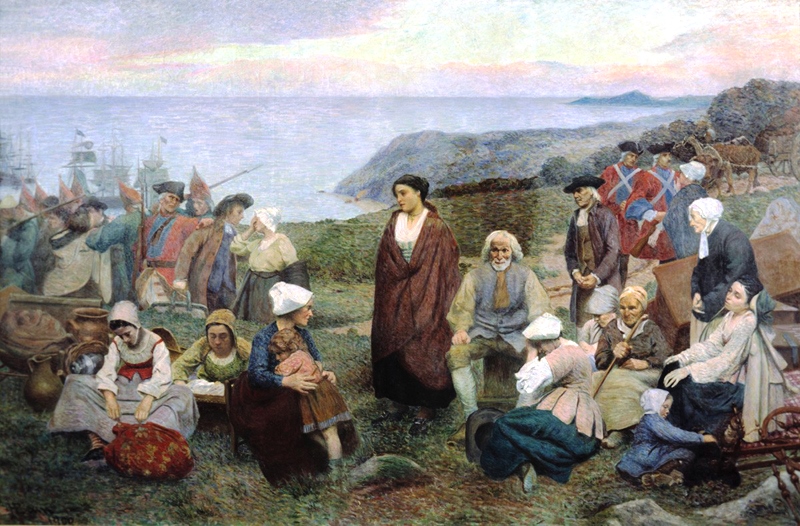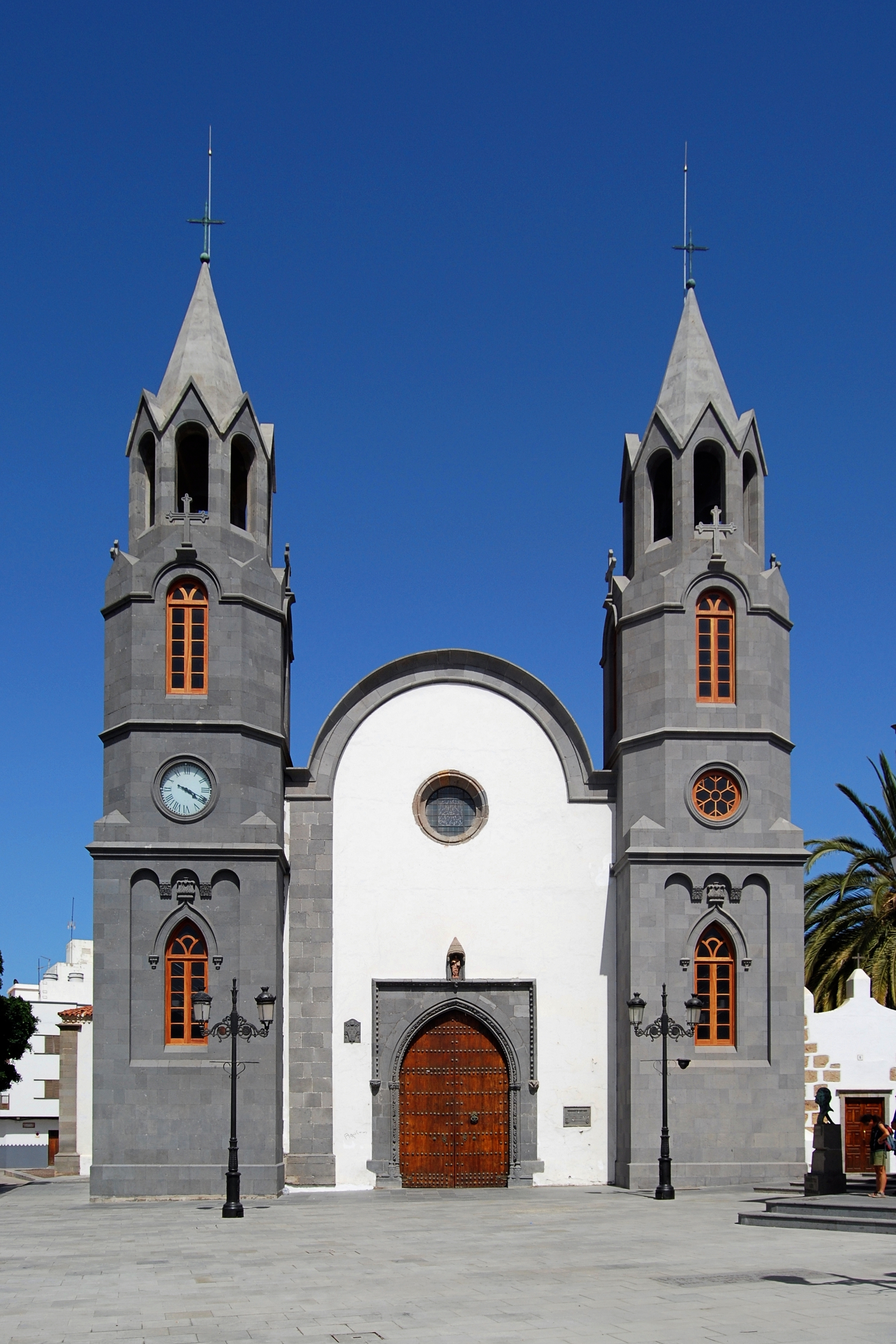|
Joe Falcon
Joseph Falcón (September 28, 1900 – November 19, 1965) was an accordion player from southwest Louisiana, best known for producing the first recording of a Cajun song, " Allons à Lafayette," in 1928. He and his wife Cléoma Breaux left for New Orleans to record the first Cajun record and went on to perform across southern Louisiana and Texas. Early life Joe was born in Roberts Cove, Louisiana located nearby Bayou Plaquemine Brule and began playing accordion at the age of seven. He was the fifth child of Pierre Illaire Falcón and Marie Arvilia Boudreaux. His family farmed cotton and sugarcane, and they made syrup. He shares both Cajun and Isleño ancestry as his paternal great-grandparents, José Félix Falcón and María Antonia Damasa Falcón, were descendants of the Canary Islander colonists who settled in Valenzuela along Bayou Lafourche. His ancestors Cristóbal Falcón and Gaspar Falcón were born in Telde, Gran Canaria. His mother Marie was of Acadian desce ... [...More Info...] [...Related Items...] OR: [Wikipedia] [Google] [Baidu] |
Roberts Cove
Roberts Cove (formerly ''German Cove''; ) is an unincorporated community in Louisiana, United States. Roberts Cove is not a town, but rather a scattered rural community with the St. Leo's Catholic church complex as a community and cultural center which is located three miles northwest of Rayne in Acadia Parish. It is part of the Crowley Micropolitan Statistical Area. History In 1867, Rev. Peter Leonard Thevis, a native priest of Langbroich, Nordrhein-Westfalen, Germany, was asked to come to New Orleans by Archbishop Jean-Marie Odin, mainly because of the large number of German immigrants there. It was on January 13, 1880, that Fr. Thevis, accompanied by his brother Peter Joseph Thevis, his nephew, John Gerhard Thevis and Herman Grein, came on this railway to Rayne, and to the prairie land three miles north of Rayne to look over the area. The site selected for the future colony was known as "Roberts Cove" named for Benjamin Roberts, the original owner of a Spanish land grant ... [...More Info...] [...Related Items...] OR: [Wikipedia] [Google] [Baidu] |
Bayou Plaquemine Brule
Bayou Plaquemine Brulé ( ; historically spelled ''Plakemine''; translating to "burnt persimmon bayou") is a waterway in the Mermentau River basin of south Louisiana. The bayou is longU.S. Geological Survey. National Hydrography Dataset high-resolution flowline dataThe National Map, accessed June 20, 2011 and is navigable for of its lower course. One of the first settlers of the area was Michel Comeau. See also *List of rivers of Louisiana List of rivers of Louisiana (U.S. state). By drainage basin This list is arranged by drainage basin, with respective tributaries indented under each larger stream's name. Gulf of Mexico East of the Mississippi *Pearl River (Mississippi–Louis ... References External links Map of the southwestern Bayou region Rivers of Louisiana Rivers of Acadia Parish, Louisiana {{Louisiana-river-stub ... [...More Info...] [...Related Items...] OR: [Wikipedia] [Google] [Baidu] |
Texas
Texas ( , ; or ) is the most populous U.S. state, state in the South Central United States, South Central region of the United States. It borders Louisiana to the east, Arkansas to the northeast, Oklahoma to the north, New Mexico to the west, and has Mexico-United States border, an international border with the Mexican states of Chihuahua (state), Chihuahua, Coahuila, Nuevo León, and Tamaulipas to the south and southwest. Texas has Texas Gulf Coast, a coastline on the Gulf of Mexico to the southeast. Covering and with over 31 million residents as of 2024, it is the second-largest state List of U.S. states and territories by area, by area and List of U.S. states and territories by population, population. Texas is nicknamed the ''Lone Star State'' for its former status as the independent Republic of Texas. Spain was the first European country to Spanish Texas, claim and control Texas. Following French colonization of Texas, a short-lived colony controlled by France, Mexico ... [...More Info...] [...Related Items...] OR: [Wikipedia] [Google] [Baidu] |
Amédée Breaux
Breaux Frères or Breaux Brothers (Amédé on accordion, Ophé on guitar, and Cléopha on the fiddle), were Cajun musicians. They were the earliest to record the song "Jolie Blonde", under the title of "Ma Blonde Est Partie". Amédé Breaux was born on September 1, 1900, north of Rayne, Louisiana, near a community called Roberts Cove, Louisiana, Roberts Cove. He died in 1973. His father, Auguste Breaux, later moved to north of Egan, Louisiana, where he farmed. Amédé started playing the accordion when he was 12 years old and was playing house parties at the age of 14. The whole family started playing music at a young age. His father, Auguste Breaux, was a well-known accordionist, and his mother played Jew's harp, mouth harp. When his brothers, Ophey and Clifford, and his sister, Cléoma Falcon, Cléoma Breaux Falcon, were old enough they played music together. That was when he recorded "Vas y Carrément (Step It Fast)" and "Poor Hobo" in 1929 for Columbia Records. After he rec ... [...More Info...] [...Related Items...] OR: [Wikipedia] [Google] [Baidu] |
Rayne, Louisiana
Rayne is a city in Acadia Parish, Louisiana, United States. With a population of 7,326 at the 2020 United States census, it is nicknamed the "Frog Capital of the World", as well as the "Louisiana City of Murals". Rayne is part of the Crowley micropolitan statistical area, and within the Lafayette metropolitan statistical area in Acadiana. History The area that would become Rayne was originally part of a large land grant awarded to French settlers in the 18th century. These settlers were primarily involved in agriculture, cultivating crops such as rice and sugarcane. The establishment of Rayne began in the 1880s with the arrival of the railroad. The city was initially named Pouppeville, after a prominent local figure, but was soon renamed Rayne in honor of Rayne Grey, an engineer for the Southern Pacific Railroad, whose efforts were instrumental in bringing the railroad to the area. The railroad not only facilitated transportation and commerce but also attracted a diverse p ... [...More Info...] [...Related Items...] OR: [Wikipedia] [Google] [Baidu] |
Acadian People
The Acadians (; , ) are an ethnic group descended from the French who settled in the New France colony of Acadia during the 17th and 18th centuries. Today, most descendants of Acadians live in either the Northern American region of Acadia, where descendants of Acadians who escaped the Expulsion of the Acadians (a.k.a. The Great Upheaval / ''Le Grand Dérangement'') re-settled, or in Louisiana, where thousands of Acadians moved in the late 1700s. Descendants of the Louisiana Acadians are most commonly known as Cajuns, the anglicized term of "Acadian". Acadia was one of the five regions of New France, located in what is now Eastern Canada's Maritime provinces, as well as parts of Quebec and present-day Maine to the Kennebec River. It was ethnically, geographically and administratively different from the other French colonies such as the French colony of Canada. As a result, the Acadians developed a distinct history and culture. The settlers whose descendants became Acadians ... [...More Info...] [...Related Items...] OR: [Wikipedia] [Google] [Baidu] |
Louisiana State University Press
The Louisiana State University Press (LSU Press) is a university press at Louisiana State University. Founded in 1935, it publishes works of scholarship as well as general interest books. LSU Press is a member of the Association of University Presses. LSU Press publishes approximately 70 new books each year and has a backlist of over 2000 titles. Primary fields of publication include southern history, southern literary studies, Louisiana and the Gulf South, the American Civil War and military history, roots music, southern culture, environmental studies, European history, foodways, poetry, fiction, media studies, and landscape architecture. In 2010, LSU Press merged with '' The Southern Review'', LSU's literary magazine, and the company now oversees the operations of this publication. Domestic distribution for the press is currently provided by the University of North Carolina Press's Longleaf Services. Notable publications and awards '' A Confederacy of Dunces'' by John Ken ... [...More Info...] [...Related Items...] OR: [Wikipedia] [Google] [Baidu] |
Baton Rouge, Louisiana
Baton Rouge ( ; , ) is the List of capitals in the United States, capital city of the U.S. state of Louisiana. It had a population of 227,470 at the 2020 United States census, making it List of municipalities in Louisiana, Louisiana's second-most populous city. It is the county seat, seat of Louisiana's most populous List of parishes in Louisiana, parish, East Baton Rouge Parish, Louisiana, East Baton Rouge Parish, and the center of Louisiana's second-largest metropolitan area, Baton Rouge metropolitan area, Greater Baton Rouge, which had 870,569 residents in 2020. Located on the eastern bank of the Mississippi River, the Baton Rouge area owes its historical importance to its strategic site upon the Istrouma Bluff, the first natural cliff, bluff upriver from the Mississippi River Delta at the Gulf of Mexico. This allowed the development of a business quarter safe from seasonal flooding. In addition, it built a levee system stretching from the bluff southward to protect the rive ... [...More Info...] [...Related Items...] OR: [Wikipedia] [Google] [Baidu] |
Gran Canaria
Gran Canaria (, ; ), also Grand Canary Island, is the third-largest and second-most-populous island of the Canary Islands, a Spain, Spanish archipelago off the Atlantic coast of Northwest Africa. the island had a population of that constitutes approximately 40% of the population of the archipelago. Las Palmas de Gran Canaria, the capital of the island, is the largest city of the Canary Islands and the ninth-largest of Spain. Gran Canaria is located in the Atlantic Ocean in a region known as Macaronesia about off the northwestern coast of Africa and about from Europe. With an area of and an altitude of at Morro de la Agujereada, Gran Canaria is the third largest island of the archipelago in both area and altitude. Gran Canaria is also the third most populated island in Spain. History In Classical antiquity, antiquity, Gran Canaria was populated by the North African Guanches, Canarii, who may have arrived as early as 500 BC. In the Middle Ages, medieval period, after ove ... [...More Info...] [...Related Items...] OR: [Wikipedia] [Google] [Baidu] |
Telde
Telde is a municipality in the eastern part of the island of Gran Canaria, Canary Islands, overseas (Atlantic) insular Spain. It borders Las Palmas to the north and is part of its urban area. It is the second most populous municipality on the island, with a population of (2013).Instituto Canario de Estadística , population Its area is . The city is the oldest and the first capital of the island of Gran Canaria, founded before 1351, a former medieval bishopric and present Catholic . The GC-1 motorway passes east of the cit ... [...More Info...] [...Related Items...] OR: [Wikipedia] [Google] [Baidu] |
Bayou Lafourche
Bayou Lafourche ( ), originally called Chetimachas River or La Fourche des Chetimaches (the fork of the Chitimacha), is a U.S. Geological Survey. National Hydrography Dataset high-resolution flowline dataThe National Map, accessed June 20, 2011 bayou in southeastern Louisiana, United States, that flows into the Gulf of Mexico. The bayou is flanked by Louisiana Highway 1 on the west and Louisiana Highway 308 on the east, and is known as "the longest Main Street in the world." It flows through parts of Ascension, Assumption, and Lafourche parishes. Today, approximately 300,000 Louisiana residents drink water drawn from the bayou. History The name Lafourche is from the French for "the fork", and alludes to the bayou's large outflow of Mississippi River water. The first settlements of Acadians in southern Louisiana were near Bayou Lafourche and Bayou des Écores, which led to a close association of the bayou with Cajun culture. It was formerly a Mississippi River outlet (distri ... [...More Info...] [...Related Items...] OR: [Wikipedia] [Google] [Baidu] |






